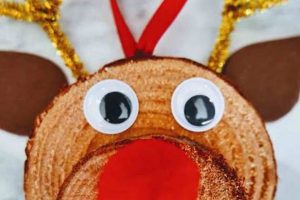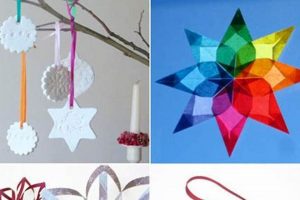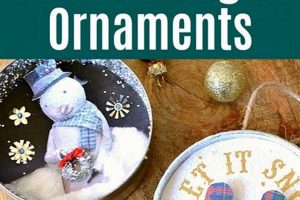The creation of decorative items reminiscent of earlier eras, intended for seasonal adornment, represents a growing trend. This practice involves utilizing various materials and techniques to produce unique, personalized objects that evoke feelings of nostalgia and historical charm. An example includes crafting tree decorations from aged paper, antique lace, and repurposed beads.
This form of crafting offers several advantages. It allows for the expression of individual creativity and the production of bespoke holiday decorations. Furthermore, it provides a sustainable alternative to purchasing mass-produced items, often incorporating recycled or repurposed materials. Historically, handcrafted holiday decorations were prevalent due to resource limitations and served as a focal point for family activity and artistic expression.
The subsequent sections will explore specific methods and resources for producing these types of decorations, focusing on techniques such as decoupage, fabric manipulation, and the utilization of readily available craft supplies. The exploration will cover techniques from simple to more complex to offer solutions for a wide variety of users.
Tips for Crafting Decorations with a Historic Aesthetic
The following recommendations are designed to assist in the effective creation of decorative items that reflect the aesthetic of past eras, resulting in unique and aesthetically pleasing holiday adornments.
Tip 1: Material Selection. Prioritize materials that exhibit a weathered or aged appearance. This includes using paper with a tea-stained finish, fabrics with a faded print, and metal elements displaying deliberate patination. These materials are fundamental to creating an item that looks genuinely old.
Tip 2: Decoupage Techniques. Explore decoupage methods using vintage imagery sourced from old books, magazines, or publicly available digital archives. Applying these images to surfaces with matte adhesive creates a convincing aged appearance and allows for customized designs.
Tip 3: Fabric Manipulation. Incorporate fabric scraps, lace, and ribbons in muted color palettes. Techniques such as gathering, pleating, and appliqu can add textural interest and replicate the embellishments found on antique decorations.
Tip 4: Beadwork and Embellishments. Employ vintage beads, faux pearls, and metal findings to add a touch of elegance and detail. These elements can be strategically placed to enhance the visual appeal and create a sense of handcrafted quality.
Tip 5: Distressing Techniques. Experiment with distressing methods to impart an aged appearance to newly crafted items. This can involve sanding edges, applying antiquing wax, or gently scuffing surfaces to create the illusion of wear and tear.
Tip 6: Color Palette Considerations. Adhere to muted and historically accurate color schemes. Soft pastels, creams, off-whites, and metallic tones evoke a vintage feel more effectively than bright, modern colors. Research historical color palettes for specific eras to ensure authenticity.
Tip 7: Secure Fastenings. Utilizing durable adhesives and secure attachment methods will ensure that each element is properly affixed. Poorly constructed joinings distract from the artistic goals, and threaten the item’s longevity.
Crafting decorative items with a historic aesthetic requires meticulous attention to detail and careful material selection. By incorporating these tips, one can produce personalized items that reflect a sense of timelessness and artistry.
The following sections will explore practical techniques, from aging paper to utilizing fabric, so as to achieve a vintage look.
1. Authentic materials
The selection of authentic materials constitutes a foundational pillar in the successful creation of decorative items intended to replicate a vintage aesthetic. The use of materials genuinely representative of the period being emulated directly impacts the credibility and visual appeal of the finished ornament. Failure to prioritize authentic or appropriately aged materials often results in an artifact that lacks the intended historical resonance.
The causal relationship between authentic materials and perceived vintage quality is demonstrable across numerous examples. Utilizing acid-free paper aged with tea or coffee yields a far more convincing antique document effect than bright, modern printer paper. Similarly, employing vintage or vintage-style lace, ribbon, and metal findings contributes significantly to the overall effect, replacing more modern synthetic materials. Sourcing these materials presents practical challenges. This can be facilitated through estate sales, antique shops, and online marketplaces specializing in vintage supplies. Repurposing aged textiles and metal components from discarded or damaged items is a viable, sustainable approach.
Ultimately, the dedication to sourcing and utilizing authentic materials is not merely aesthetic. It represents a commitment to historical accuracy and a tangible demonstration of the craftsmanship inherent in vintage design. Successfully navigating the challenges associated with sourcing such materials is central to producing decorative items that are both visually appealing and historically informed, thus realizing the goal of creating ornaments with a true vintage character. This, in turn, strengthens the link with the broader theme of appreciating and preserving historical craft traditions.
2. Distressing techniques
Distressing techniques represent a set of deliberate methods employed to impart an aged or worn appearance to newly created items. Within the context of crafting decorative items with a historic aesthetic, mastering these techniques is crucial for achieving a convincing replication of vintage characteristics.
- Sanding and Abrasion
Sanding and abrasion involve the removal of material from the surface of an item to expose underlying layers or create uneven textures. In practice, fine-grit sandpaper can be used to gently wear down edges and corners, simulating the natural wear and tear experienced by antique items over time. The resulting visual effect suggests prolonged use and exposure, thereby enhancing the vintage authenticity of the piece. For instance, lightly sanding the edges of paper or wooden elements creates a subtle yet effective indication of age.
- Staining and Antiquing
Staining and antiquing techniques involve the application of tinted substances to alter the color and tone of a material, simulating the effects of oxidation, dirt accumulation, and aging. This can involve applying dark stains and then wiping away the excess, leaving a residue that settles into crevices and enhances texture. For example, applying antiquing wax to a painted surface and then buffing it can create a subtle, aged patina. This technique is especially effective on wood and metal surfaces.
- Crackling and Chipping
Crackling and chipping are techniques designed to create the appearance of aged paint or varnish, replicating the natural degradation that occurs over decades of use. Crackle paint or medium can be applied to a surface, causing the subsequent layer of paint to crack as it dries, revealing the base coat beneath. Similarly, chipping can be simulated by carefully removing small portions of paint or applying a specialized chipping medium. The visual effect of these techniques suggests that the item has undergone significant environmental stress, thus lending credibility to its aged appearance.
- Tea Staining and Dyeing
The employment of tea or coffee staining to paper or fabric materials facilitates the introduction of a subtle, aged tint. The immersion of these materials in a diluted solution of tea or coffee infuses a yellowed or browned tone, effectively replicating the discoloration that naturally occurs over time. The result is a more authentic representation of paper or fabric that has undergone prolonged exposure to environmental factors, thereby bolstering the vintage aesthetic.
The deliberate application of distressing techniques, such as sanding, staining, crackling, and tea staining, is essential for achieving an authentic vintage appearance in handcrafted decorative items. These techniques contribute to the creation of items that visually communicate age, history, and character.
3. Period-correct patterns
The integration of period-correct patterns constitutes a critical element in the successful execution of “diy vintage ornaments.” These patterns serve as visual anchors, immediately situating the crafted item within a specific historical context. Deviations from these established designs can compromise the overall authenticity and diminish the intended evocation of a bygone era. A cause-and-effect relationship exists: the accurate reproduction of period-specific patterns directly results in heightened perceived vintage authenticity. For example, utilizing Art Deco geometric motifs on an ornament intended to emulate the 1920s contributes significantly to its historical credibility. Conversely, the incorporation of contemporary designs or anachronistic elements undermines the effect.
The importance of period-correct patterns extends beyond mere aesthetic appeal. They represent tangible links to the artistic and cultural sensibilities of specific time periods. The study and application of these patterns provide insight into historical design trends, material availability, and societal values. For example, the use of stylized floral patterns characteristic of Victorian-era decorations reflects the era’s emphasis on sentimentality and naturalism. Furthermore, the practical application of this understanding enables creators to make informed decisions regarding material selection, color palettes, and embellishment techniques, reinforcing the overall cohesive vintage aesthetic. Accessing and adapting these patterns is often facilitated through historical archives, museum collections, and online repositories of vintage design resources.
In summary, the strategic selection and implementation of period-correct patterns are indispensable for crafting “diy vintage ornaments” that resonate with historical accuracy and visual appeal. While challenges may arise in sourcing authentic patterns or adapting them to contemporary crafting techniques, the commitment to historical accuracy significantly enhances the overall value and impact of the finished product. This focus ultimately contributes to a deeper appreciation of historical design and strengthens the connection between the crafted ornament and its intended historical context.
4. Muted color palettes
The selection of muted color palettes is intrinsically linked to the authentic representation of “diy vintage ornaments.” These palettes, characterized by subdued tones and desaturated hues, are not merely aesthetic choices but rather fundamental components that convey the age and historical context of the crafted items. A direct cause-and-effect relationship exists: the utilization of muted colors contributes significantly to the perceived vintage authenticity, while the introduction of vibrant, contemporary colors diminishes the historical accuracy of the ornament. For instance, employing a palette of faded blues, creams, and soft golds on a Christmas tree ornament evokes a sense of the early 20th century, while the use of bright neon colors would immediately contradict that intended historical feel.
The importance of muted color palettes stems from their reflection of historical pigment availability and the effects of time on color saturation. Prior to the advent of modern synthetic dyes, pigments were derived from natural sources, resulting in a more limited and less intense range of colors. Furthermore, the passage of time causes colors to fade and lose their original vibrancy due to factors such as exposure to light and environmental conditions. Therefore, the use of muted colors accurately reflects the visual characteristics of objects that have aged naturally. This knowledge has practical applications in material selection, paint mixing, and decorative techniques. For example, crafters can intentionally desaturate colors by adding white or gray pigments to achieve a more muted effect, or they can utilize techniques such as dry brushing to create a faded and worn appearance. When emulating a Victorian aesthetic, for example, deep burgundies, forest greens, and dusty roses provide a historically appropriate base.
In summary, the adherence to muted color palettes is essential for crafting “diy vintage ornaments” that authentically capture the essence of bygone eras. While challenges may arise in accurately replicating historical color schemes or achieving the desired level of desaturation, the dedication to utilizing muted colors significantly enhances the credibility and visual appeal of the finished product. This contributes to a deeper appreciation of historical aesthetics and strengthens the connection between the crafted ornament and its intended historical context. The subtle effect of properly deployed muted color schemes ultimately enhance the authenticity of the design.
5. Delicate embellishments
Delicate embellishments serve as integral components of handcrafted decorative items intended to emulate a vintage aesthetic. The addition of fine, intricate details often determines the perceived quality and historical accuracy of these ornaments. A direct causal relationship exists: the meticulous application of delicate embellishments enhances the overall visual appeal and reinforces the intended evocation of a bygone era. For example, the incorporation of fine lace trim, miniature pearl beads, or hand-stitched embroidery on a tree decoration significantly contributes to its vintage character. Conversely, the absence of such embellishments or the use of overly simplistic decorations diminishes the perceived authenticity and historical resonance of the object.
The importance of delicate embellishments extends beyond mere surface decoration. These details frequently reflect the craftsmanship and artistic sensibilities of specific historical periods. The intricate beadwork and elaborate trims characteristic of Victorian-era decorations, for instance, exemplify the era’s emphasis on ornamentation and detailed craftsmanship. This can have practical application when making design choices for vintage ornaments; for instance, one can implement embellishments from different areas to achieve a unique look. Moreover, the act of creating these embellishments by hand underscores the value placed on artisanal skills and personalized touches, which were central to decorative arts before mass production. Understanding this historical context enables craftspeople to make informed decisions regarding material selection, embellishment techniques, and overall design aesthetic, leading to a more cohesive and convincing representation of a vintage style.
In summary, the careful consideration and application of delicate embellishments are essential for crafting decorative items that authentically capture the essence of vintage aesthetics. While challenges may arise in sourcing vintage-appropriate materials or mastering intricate embellishment techniques, the commitment to incorporating these details significantly enhances the value and impact of the finished product. This attention to detail contributes to a deeper appreciation of historical craftsmanship and strengthens the connection between the crafted ornament and its intended historical context. It is an understanding, and practical use of delicate embellishments that distinguishes a well made from a lacking one.
6. Handcrafted quality
The concept of handcrafted quality holds significant relevance in the domain of decorative items, specifically those crafted with a vintage aesthetic. The presence of handcrafted quality elevates the perceived value and authenticity of such items, distinguishing them from mass-produced alternatives. The subsequent exploration will delineate facets of handcrafted quality and their impact on the creation of vintage-inspired decorative items.
- Material Integrity
The selection of high-quality materials forms the foundation of handcrafted quality. This encompasses the choice of durable fabrics, authentic embellishments, and structurally sound bases. For “diy vintage ornaments,” this might involve selecting vintage or vintage-inspired fabrics like lace or linen, sourcing antique beads or buttons, and utilizing sturdy, age-appropriate paper stock. The use of inferior materials undermines the perceived value and longevity of the finished product.
- Precision in Execution
Handcrafted quality is characterized by meticulous attention to detail in the execution of each step of the crafting process. This involves precise cutting, careful stitching, and the accurate application of embellishments. In the context of “diy vintage ornaments,” this might manifest as perfectly aligned seams in fabric ornaments, evenly spaced beadwork, or the skillful distressing of paper elements. Deviation from precision compromises the overall aesthetic appeal and reduces the perceived value of the item.
- Unique Imperfections
Paradoxically, handcrafted quality also embraces the presence of unique imperfections that distinguish each item as individually made. These imperfections, such as slight variations in stitching or minor irregularities in shape, serve as hallmarks of handcrafted authenticity, differentiating the item from mass-produced counterparts. Within the context of “diy vintage ornaments,” these imperfections might involve subtle variations in hand-painted designs or slight inconsistencies in the application of distressing techniques. These irregularities contribute to the perceived charm and uniqueness of the finished ornament.
- Durability and Longevity
Handcrafted quality often implies a higher level of durability and longevity compared to mass-produced items. This stems from the careful selection of materials, the precision of execution, and the attention to structural integrity. For “diy vintage ornaments,” handcrafted quality can ensure that the ornament withstands years of use and display without significant degradation. This characteristic enhances the heirloom potential of the item, transforming it from a mere decoration into a cherished keepsake.
The integration of these facets contributes significantly to the overall perceived quality and authenticity of “diy vintage ornaments.” The careful consideration of material integrity, precision in execution, embrace of unique imperfections, and focus on durability distinguishes these items as valuable expressions of craftsmanship and historical appreciation, thus bolstering their appeal and long-term value.
Frequently Asked Questions about crafting Vintage Ornaments
This section addresses common inquiries and potential misconceptions regarding the creation of decorative items designed to evoke a vintage aesthetic.
Question 1: Is specialized equipment necessary to create vintage style ornaments?
The creation process does not necessitate specialized equipment. Basic craft supplies, such as scissors, adhesives, and paintbrushes, are typically sufficient. However, certain techniques, such as decoupage or intricate beadwork, may benefit from specialized tools, though these are not essential for all projects.
Question 2: How does one ensure the historical accuracy of vintage-inspired decorations?
Historical accuracy is ensured through meticulous research of the design elements, materials, and techniques prevalent in the desired era. Reference materials, such as historical archives and museum collections, serve as valuable resources. Furthermore, adherence to period-correct color palettes and embellishment styles contributes to authenticity.
Question 3: What constitutes an authentic vintage color palette?
An authentic vintage color palette typically comprises muted tones, desaturated hues, and colors derived from natural pigments. Examples include creams, beiges, soft golds, dusty pinks, and faded blues. These colors reflect the limited availability of synthetic dyes and the effects of time on color saturation.
Question 4: How can one age new materials to create a vintage aesthetic?
Various techniques facilitate the aging of new materials. Tea staining or coffee staining imparts an aged tint to paper and fabric. Sanding and distressing techniques create the appearance of wear and tear. Antiquing waxes and glazes alter the color and texture of surfaces, simulating the effects of time.
Question 5: Are vintage materials required to create vintage-inspired ornaments?
While vintage materials enhance the authenticity of the finished product, they are not strictly required. Appropriately aged or vintage-inspired materials can effectively replicate the desired aesthetic. Sourcing vintage materials can present challenges, making reproduction materials a viable alternative.
Question 6: How does one prevent the creation of decorations that appear merely “old” rather than authentically vintage?
Achieving an authentic vintage aesthetic requires more than simply making an item look old. It entails careful attention to design details, material selection, and craftsmanship techniques that reflect the specific historical period being emulated. A thorough understanding of the era’s artistic and cultural sensibilities is crucial.
The creation of convincing vintage-style decorative items necessitates a blend of technical skill, historical awareness, and artistic sensibility. Attention to detail is very important.
The article will now provide specific tips for sourcing and assembling vintage ornaments.
Conclusion
This exploration has illuminated the multifaceted aspects of “diy vintage ornaments,” underscoring the importance of authentic materials, period-correct patterns, muted color palettes, delicate embellishments, and handcrafted quality. Each of these elements contributes significantly to the creation of decorative items that resonate with historical accuracy and aesthetic appeal. Distressing techniques, accurate pattern selection, and a careful selection of colors were essential for a successful outcome.
The crafting of vintage ornaments represents more than a mere decorative pursuit; it signifies an engagement with historical design, craftsmanship, and cultural values. The continued pursuit of these skills will ensure the preservation and appreciation of these historical traditions. The creation of ornaments provides lasting benefits.







